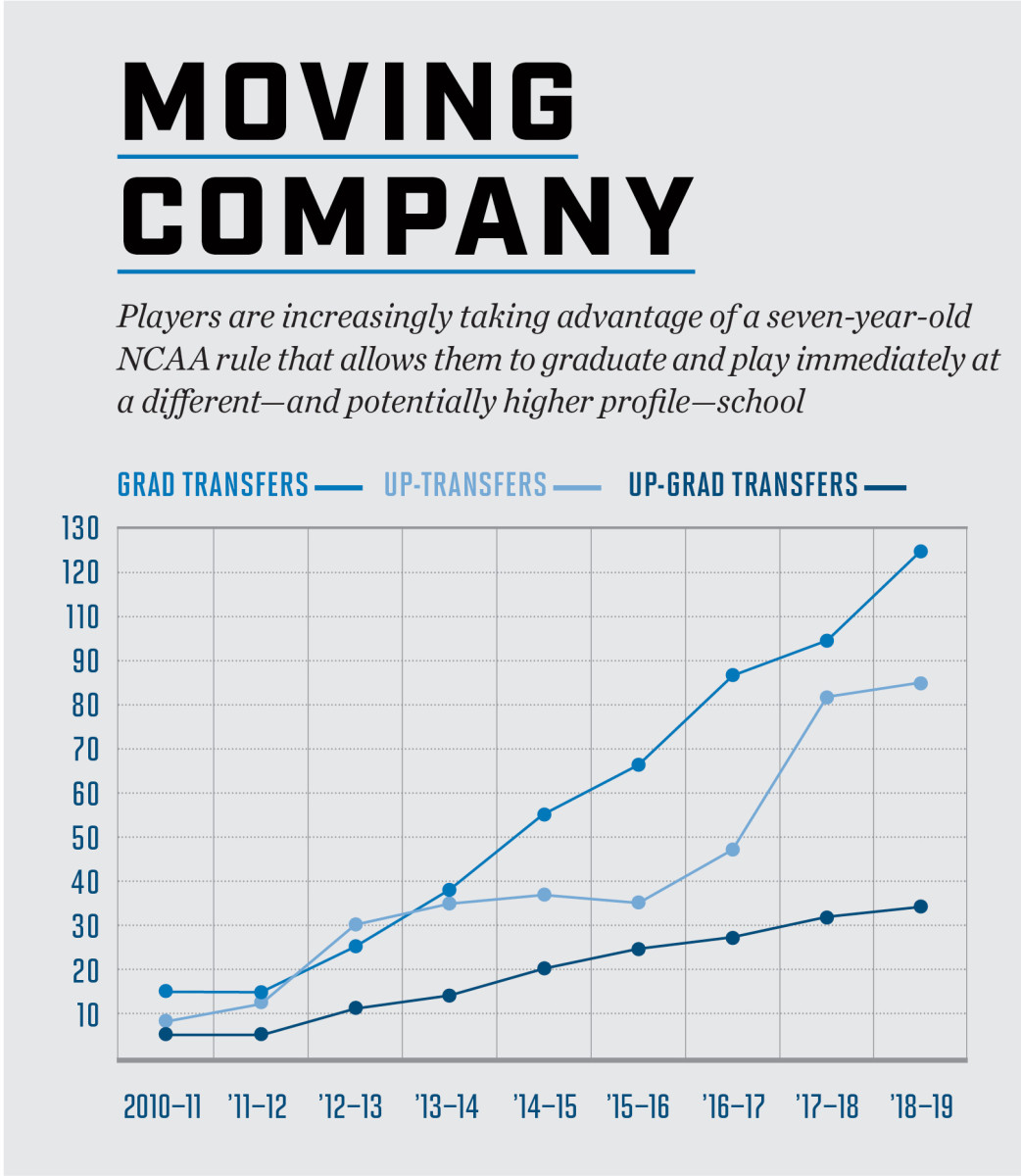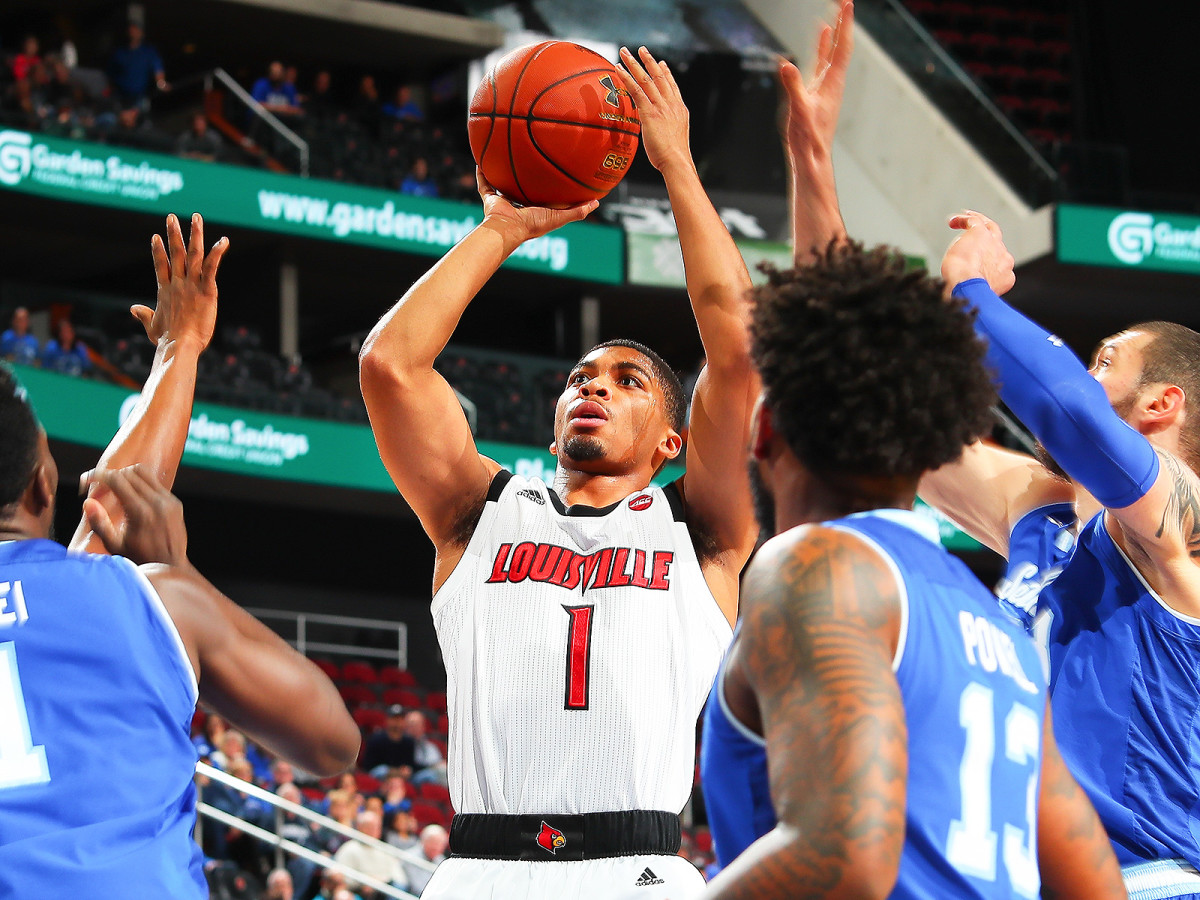Up-Grad Transfers Are Here to Stay—and Their Impact on College Hoops Is Greater Than Ever

This story appears in the Dec. 3, 2018, issue of Sports Illustrated. For more great storytelling and in-depth analysis, subscribe to the magazine—and get up to 94% off the cover price. Click here for more.
Among the most important one-and-done players in this young college basketball season is a 23-year-old with 104 games of Division I experience, two first-team All-Pac-12 selections and a bachelor's degree in science, technology and society from what U.S. News & World Report ranks the country's seventh-best university. When power forward Reid Travis announced last June that after graduating from Stanford he would enroll at Kentucky for his final season of collegiate eligibility, he ignited instant national championship buzz by giving the young Wildcats—who were already adding four five-star freshmen to three of last season's five-star freshmen—the sort of experienced complement that their rosters of wunderkinder typically lack. "He's a grown man," says Kentucky coach John Calipari of Travis, animated with delight. "The other day I called him 'kid.' He was like, What?"
Not long ago a move such as Travis's would have been impossible without a personal hardship waiver from the NCAA. But Travis, who received a medical redshirt for 2015–16 after suffering a stress fracture in his left leg, took advantage of the NCAA's much-discussed graduate transfer exemption. Passed in '06, the rule permits a player who retains a year of athletic eligibility after gaining his undergraduate degree to play as a grad student at another school without having to sit out a full season. The number of players using it has risen from 15 in '10–11 to 124 this year, an increase of 733%.
At the same time, Travis's move is reflective of another trend: an increase in so-called "up-transfers." Introduced in 2012 by then SI writer Luke Winn (now the director of prospect strategy for the Raptors), the term refers to players who move up from a mid-major to a major program; or from a less-decorated major (Northwestern or, yes, Stanford) to one with a recent national championship; or from an obscure mid-major to an elite one, such as Gonzaga or San Diego State. In '10–11 there were nine such players. This year there are 84. Increasingly, climbing the ladder of college basketball is no longer just an activity for coaches and administrators.
These trends have overlapped to create a new phenomenon: the up-grad transfer, like Travis. In 2010–11 there were five such players; this season there are 33, and prominent examples abound, such as Gonzaga guard Geno Crandall (who transferred from North Dakota), guard Joe Cremo of Villanova (formerly of Albany) and Florida State guard David Nichols (also an Albany alum). Oklahoma's backcourt is relying on Aaron Calixte and Miles Reynolds, who came from Maine and Pacific, respectively. First-year Louisville coach Chris Mack brought in three up-grad transfers, while Mack's replacement at Xavier, former assistant Travis Steele, landed three as well. And after just one season as a starter at Old Dominion, forward Javan White is now in the rotation at Clemson.
Like all transfer-related topics, this burgeoning subgenre has engendered controversy. Proponents praise the rule for providing athletes more agency in a multibillion-dollar industry that offers little of it. Detractors (read: coaches) decry the rule because it lessens the reward for player development, hurts smaller programs' ability to build their rosters and encourages player movement by removing the deterrent of needing to sit out. No less an authority in the sport than Duke's Mike Krzyzewski has called transfer exemptions "a farce."
Another persistent critic: Calipari. He says that before Travis he refused to accept any graduate transfers, not wanting to weaken a less established team and, more important, harm a colleague's career. (Three years ago Bruiser Flint, Calipari's longtime friend and Drexel's coach, lost his best player, Damion Lee, as a grad transfer to Louisville, then was fired after going 6–25.) But Calipari says Travis's move is "a totally different scenario" because he is coming from a Pac-12 school, not a mid-major. In typical Cal fashion, he believes that his change of heart will be a net plus for the sport.
"Now that we've taken a kid, it'll be the impetus for the NCAA to change the rule," he says. "Because if we're benefiting from it, the rule is bad." But given that the NCAA has been inclined to (incrementally) increase the benefits available to its athletes, grad transfers are likely here to stay. In fact, the NCAA's academics committee recently recommended that all transfers be eligible to play immediately if they meet certain educational benchmarks. Which means rather than becoming a fleeting trend, up-grad transfers might represent college basketball's future.
For a rule that has drawn such scorn, its initial passage attracted little attention. At its April 2006 meeting, the NCAA's board of directors, on a recommendation from the body's academics, eligibility and compliance cabinet, voted 13–4 to permit athletes in all sports who receive their degrees to begin graduate studies at a new school and play with no penalty. It wasn't until CBS reported on the revised rule a month later that many coaches even knew it existed. Immediately, football and basketball coaches began wringing their hands about stability and commitment and free agency. Then Arkansas coach Stan Heath (who now guides the G League's Lakeland [Fla.] Magic), spoke to the Memphis Commercial Appeal and quickly identified a potential pitfall. "As a coach," he said, "now you're thinking that maybe your players shouldn't take so many summer courses, that you might want to slow down the progress toward a degree a bit."
The NCAA's full membership overrode the rule in a vote the following January, but a new provision was subsequently added: An athlete could play right away only if the chosen grad program was not offered at his original school. It had been used just once in its first year, when, after Arizona State fired coach Rob Evans, Kevin Kruger left to play for his father, Lon, at UNLV, where he studied criminal justice. The first up-grad transfer in hoops came in 2008, when center Bassirou Dieng left Saint Francis (Pa.) for Georgia Tech.
It wasn't until after the rule was modified in 2011 to apply to all graduate transfers, regardless of study program, that grad transfers became appealing as low-stakes, short-term investments for coaches needing experienced players. In the first full season after that change, '12–13, the total number of men's college basketball grad transfers rose from 15 to 25, and up-grad transfers went from five to 11—a rate of increase that continued into this season's new highs of 124 and 33 up-grad transfers. The latter also began playing important roles on teams that reached the Sweet 16 (Michigan State guard Brandon Wood, a Valparaiso graduate, in '12), the NCAA title game (Ohio alum Jaaron Simmons, a point guard with Michigan last season) and the national championship podium (UConn guard Lasan Kromah, a George Washington grad, in '14).
Coaches' complaints intensified as well. By 2017, Iowa's Fran McCaffery was declaring it "the worst rule in the history of college basketball." Says Villanova's Jay Wright, "I don't know any coach that likes it." Some invoke the potential instability of what Northwestern coach Chris Collins has called "ultimate free agency," or contend that losing such veteran players could set back mid-major contenders. Still others cite an NCAA study's finding that only 34% of graduate transfers in men's basketball obtain an advanced degree within two years (a statistic that does not account for players who pursue professional careers after their one postgrad season, then may complete their studies at a later time).
But in college sports, necessity often supersedes ideals. Wright, like Calipari, had long rejected grad transfers on principle, until this spring, when he lost the top four scorers from a national-title-winning team. Oklahoma's Lon Kruger—whose groundbreaking grad-transfer son, Kevin, is now a Sooners assistant helping to coach the team's two grad-transfer guards—says that "if the rule's there, there's nothing wrong if everybody uses it to benefit themselves and their programs. But I still don't think it's healthy for the majority of the programs."
"If we're in a discussion with the coaches from the [Power 5] conferences," says National Association of Basketball Coaches executive director Jim Haney, "they say, I don't like it, but I know I could end up playing against these guys, so I end up recruiting them."
Yet all their shouting is likely for naught. Public sentiment is increasingly shifting toward players' rights, a movement championed by ESPN analyst and Duke alum Jay Bilas, who strongly supports the grad transfer rule. "If you were a late-bloomer," says Bilas, "and you were recruited into a situation that you have outgrown, you're not allowed to better yourself?" Of the argument that the program that first identified and developed the player should reap his peak production Bilas brings up the job-hopping of college administrators and coaches. "Do we apply that standard to any other area of university life?" Bilas says. "Why wouldn't we say, Man, that's great that that player has that opportunity?"
"Coaches are essentially free agents every year while they're under contract," says Louisville guard Christen Cunningham, a grad transfer from Samford. Only 2.3% of men's basketball players nationally are grad transfers. By comparison, 13 of 310 (4.2%) Division I head coaches who remained under contract at their schools left to coach elsewhere this past offseason.

Coaches are adapting to the new landscape. Staffs now circulate lists of players who might be eligible to become grad transfers; many fear their players will be courted by other programs. One mid-major coach told ESPN anonymously two years ago that his team was "slowing down the graduating process" and nixing potential summer courses so that players would be less likely to graduate before exhausting their eligibility.
"It's something that you have to look at," says Samford coach Scott Padgett, who lost three players as graduate transfers before this season. He adds that he would not limit his players' coursework during the traditional school year. "We're not gonna be the guys that are behind their back saying, 'Oh, let's change their major.' Now, we might do [fewer classes] in the summer."
Padgett and Albany's Will Brown are the coaches most affected by the loss of grad transfers. Padgett's four-year build to last season was wrecked by injuries that eventually resulted in two of his players transferring and leaving him with just two seniors; Brown enters this season with nine new players, three of them freshmen. "I tell my kids every day: Control the controllables," Brown says. "I'm not sure this is a controllable for a coach right now. You just do your best."
"The majority of kids probably don't grow up dreaming of playing basketball at Samford," says Padgett, comparing his program with schools such as Duke and Kentucky, his alma mater. "Now this rule basically has given kids that are going to Samford a chance at some of that."
Cunningham had been the first recruit Padgett called when he was promoted from Bulldogs assistant four years ago. The 6' 2" guard started every game for three seasons, then last winter contracted mononucleosis, which left him bedridden for seven weeks. Cunningham was granted a medical redshirt and after the season spoke with his roommate, Wyatt Walker, who also received a medical redshirt after missing all but two games with a right knee injury, and teammate Justin Coleman, who had previously redshirted after transferring from Alabama. All three had the option to grad transfer to more prestigious programs; all three took it. "It was kind of a group decision," says Cunningham. They spent the spring holding daily 5 a.m. workouts at a nearby YMCA that served as showcases for visiting coaches, who looked on as white-haired members jogged laps on an elevated track.
Walker wound up at NC State, Coleman at Arizona. Cunningham, who grew up in Georgetown, Ky., rooting for both major in-state basketball powerhouses, transferred to Louisville, where his older brother had once been a student manager. Cunningham says he understands coaches' concerns about "wanting to keep their guys," but when he saw photos from early practices, with the Cardinals' championship banners on display behind him, that argument felt faraway. "It hit me," he says, "like, man, to see myself in a Louisville jersey for the first time...." He trails off, grinning.

Cremo still laughs when he hears himself described as a "shooter." He rarely pulled from outside while at Scotia-Glenville (N.Y.) High, where at 6' 4" he often manned the three and four spots for a team that twice won the state's Class A title. In part because he played upstate in New York's smallest division and shunned the AAU circuit, Cremo landed just one D-I scholarship offer: to play at Albany, 20 miles from home. He starred for the Great Danes for three seasons, averaging 17.8 points and making 45.8% of his threes last year, and was told by his academic adviser that he could complete his degree by this summer. When he decided to "take a chance on myself," as Cremo says, by graduating and going to play elsewhere, his second recruiting experience blew his high school one out of the water. By the end of the first day he had received 10 phone calls. Eventually the number of interested schools neared 30.
He chose Villanova, where he would help the defending champions mitigate the unexpected departure of combo guard Donte DiVincenzo, who would have been a junior, to the NBA. For Cremo, that has meant both adjusting from Albany's more structured, dump-it-into-the-post offense to the Wildcats' shoot-'em-up mentality and accepting that Villanova would be looking for his leadership as much as his basketball skills. Cremo scored 10 points in 18 minutes in Nova's opening-night win over Morgan State and has emerged as the struggling Wildcats' top three-point shooter, at 48.0%. "We're getting everything that we need out of [Cremo]," says Wright. "I want him to get everything that he wants out of it."
What Calipari wants Travis to get out of their new partnership is simple: To win, yes, but also to improve as a player and boost his standing as a potential pro. After graduating from Stanford, where he never reached the NCAA tournament, the 6' 8", 238-pound Travis tested the NBA draft waters. In group workouts coaches assigned him to defend guards, an assignment he rarely drew for the Cardinal. He was told to slim down and ditch his bully-ball interior style for a future as a small-ball center. Once Travis put the NBA on hold for another year, Calipari lured him to Lexington with a similar pitch. "The things that Kentucky wanted me to work on were the same things the NBA teams were telling me," says Travis, who is second on the Wildcats with a 14.6 scoring average.
Others are making their own adjustments quickly too. Oregon guard Ehab Amin, late of Texas A&M-Corpus Christi, is averaging 7.6 points for the Ducks, while Indiana forward (and Saint Mary's alum) Evan Fitzner scored 16 points in the Hoosiers' rout of Marquette.
Already next year's crop of players making a leap in levels, degree in hand, may be taking shape. The coaches they're leaving won't like it; the ones they're joining may not either. But it is their game's reality, and unlike the players in question, it's not going anywhere.
